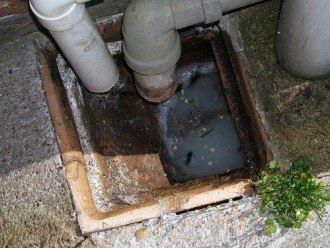Listen to our podcast on this subject.
Blocked drains are often a very smelly and dirty problem. As a householder, you are responsible for your entire drainage system up to where it joins the main sewer. The council can sometimes cover costs for repairing and maintaining communal drains. Contact them to find out who has responsibility for your drainage system.
Below are some hints for unblocking drains. If these don’t work then a professional may need to be called.
Unblocking a drain
- Lift the drain inspection cover nearest to the house to see if the chamber is full. If it is empty, the blockage is somewhere in the soil pipe from the house to the chamber. If there's water in the inspection chamber, the problem is further along the pipework. Check the next chamber until you have isolated the problem area - between full and empty inspection chambers.
- Screw together two or three of the drain rods and the plunger head and push the end into the pipe opening, towards the blockage. Slowly rotate the rods clockwise to make it easier to push them forward. Never twist them anti-clockwise or the rod connectors will come apart in the drain.
- Keep adding extra sections of drain rod until you feel resistance in the pipe. Move the plunger quickly back and forth to try and dislodge the blockage. If this doesn't work, remove the rods and fit the screw attachment. Keep twisting and pushing the rods until water flows through
Unblocking a basin or bath
If water is draining slowly from a shower, bath or sink, the cause is often hair trapped in the plughole or trap. Once you've checked that this isn't the problem:
- Block the overflow and run a small amount of water into the bowl.
- Place the plunger over the plughole and push up and down quickly to force a jet of water through the waste pipes. Take out the plunger and check the water drains away quickly. Run the taps for several minutes and remove the block from the overflow.
- If the blockage hasn't been shifted, place a container under the plastic trap. Unscrew the trap, remove and clean. You may find hair or debris in the trap. Run the water to see if the blockage is cleared.
- If there is still a problem try unscrewing the trap and using a piece of flexible wire or a toilet auger to clear it.
Unblocking a toilet
Toilet plungers work in the same way as the smaller sink versions but the head is shaped to fit a toilet pan. You can also get plungers with a pump action handle that are effective at forcing water around the pan, clearing the blockage.
For compacted blockages, try using a flexible metal wire with a handle, called a toilet auger. Feed the wire into the pan and wind the handle when the wire meets the obstruction. Pull out the blockage and flush the toilet several times.
Chemicals
Chemicals can be useful in clearing drain blockages but they can’t solve large blockages and you need to be very careful when using them. Always wear protective gloves and goggles and follow the instructions.
Tips to prevent blocked drains:
- Avoid putting fat down sinks as it congeals and clogs the drain.
- Don’t put baby wipes down toilets as they don’t break up and can very easily clog drains.
- Clean hair from traps regularly.
- Avoid putting mud or sand down sinks.
- If you drop anything down the loo, don’t flush it and hope for the best as it may lodge further down the pipe. Remove it before flushing.
